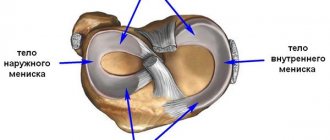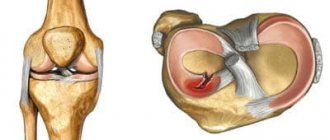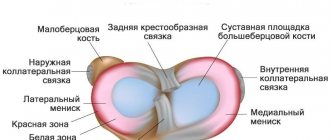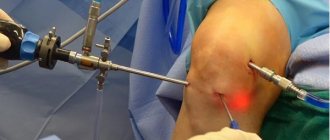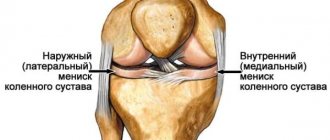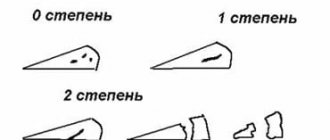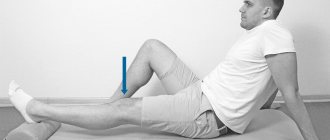There are 2 menisci in each knee joint. They are crescent-shaped cartilages and provide a tight junction of the articular surfaces of the bones that form the knee joint - the femur and tibia. The menisci are also involved in distributing the load and maintaining knee stability. Therefore, they are its most important component, and the ability of the knee joint to function properly depends on their condition.
Like any cartilaginous structures, menisci tend to wear out over the years, which leads to changes in their structure and disruption of functioning. This is called degenerative changes. A number of factors accelerate these undesirable processes, so today degenerative changes in the menisci can be detected even in middle-aged and young people. In any case, the situation requires medical intervention, since in advanced cases, the altered menisci are unable to perform their functions, which provokes not only severe pain in the knee, but can even lead to its complete immobilization.
Types and features of degenerative changes in the menisci
There are 2 menisci in each knee joint. They have approximately the same shape, although they differ slightly in size. The meniscus located on the inside of the knee joint is called medial, and the opposite one is called lateral. The ends of the menisci are called horns. The end located at the front (frontal) part of the knee joint is called the anterior horn, and the opposite end is called the posterior horn. Due to the peculiarities of its structure and location, the posterior horn of the medial meniscus is more often subject to degeneration. Although changes can occur in both the anterior horn and its central part.
But usually manifesting itself clearly in a specific area, degenerative changes, although to a lesser extent, are present in all other parts of the meniscus, from slight softening to bone exposure. However, they can occur in different ways, including:
- abrasion of the free edge;
- central degeneration, when a compaction forms in the middle of the meniscus;
- expansion of the meniscus, i.e. increasing its size between the free edge and adjacent to the bone;
- horizontal gap in the central part;
- the formation of small torn off “shreds” like a fringe;
- degenerative flap tears;
- widespread fibrillations of the entire meniscus.
Degenerative changes are the most common type of meniscal damage. They are often combined with damage to the ligaments, synovial membrane of the knee joint, and articular surfaces of the bones.
But do not confuse degenerative changes in the menisci with their traumatic tears and other types of damage. Degeneration can either lead to their occurrence over time or become a consequence of previous injuries. But in both cases it is a long, slowly progressive process of destruction of the meniscus. Thus, damage and degenerative changes in the menisci are closely interrelated and are often observed in parallel, but are not identical concepts.
Changes in the condition of the menisci affect the distribution of load on all joints of the body and the biomechanics of movements. Therefore, with their degeneration, the risk of developing deforming osteoarthritis in other joints sharply increases.
Causes
The main reason for changes in the structure and structure of the menisci of the knee joint are age-related changes. Due to a decrease in the intensity of metabolic processes, the cartilaginous elements of the joints, including the knees, gradually dehydrate and wear out. As a result, they lose their elasticity and ability to withstand stress, which leads to the occurrence of certain degenerative changes in them.
But there are factors that can speed up this process or trigger its onset at a young age. This:
- injuries of the knee joint (most often lead to damage to the medial meniscus);
- active sports, especially at a professional level;
- engaging in heavy physical labor (loaders), in which a large load falls on the entire body and the knee joints in particular;
- obesity, because the greater the body weight, the greater the load on the cartilage of the joints and the sooner they become deformed.
One of the common causes of degenerative changes in the menisci of the knee joints are chronic inflammatory and degenerative-destructive diseases of the knee joint, accompanied by a decrease in the intensity of cartilage nutrition and their frequent traumatization by altered elements of the joint. This is typical, first of all, for gonarthrosis or arthrosis of the knee joint. In the vast majority of cases, it is diagnosed in people over 50 years of age.
With gonarthrosis, degenerative-dystrophic changes are observed in the cartilaginous layers covering the articular surfaces of the femur. As a result, they become thinner, which leads to exposed bone. This is not only accompanied by pain when moving, but also leads to injury to other components of the knee, especially the menisci.
Meniscus degeneration is found in 27% of patients with grade 1 knee arthrosis. And when it progresses to grades 2 and 3, almost 100% of patients develop degenerative changes in the menisci.
Also, degenerative changes in the menisci can occur against the background of a number of other systemic diseases. In such cases they are called meniscopathies. They may be a consequence of:
- rheumatoid, gouty arthritis;
- bone tuberculosis;
- brucellosis;
- yersiniosis;
- dysfunction of the endocrine system, for example, hypothyroidism;
- systemic vasculitis;
- scleroderma, etc.
Symptoms of degenerative changes in the menisci
The main manifestation of degeneration of the menisci of the knee joints is periodic aching pain. Most often they appear after the start of movement after rest, and then intensify after walking, playing sports or physical work. Over time, the pain syndrome gains intensity, which indicates the progression of degenerative changes.
It is also possible that:
- mobility impairments, discomfort while walking, especially on stairs;
- crunching and clicking in the knee during movements;
- a feeling of knee instability (patients often say that they cannot rely on their knee);
- sensation of friction inside the knee joint.
Fragmentation of the free edge of the lateral meniscus can be completely asymptomatic.
If, against the background of this, a rupture or other damage to the meniscus occurs, acute, sharp pain is observed at the time of injury. If the torn piece of cartilage gets under the moving articular surfaces, the knee will be locked in a bent position. Any attempts to straighten it will be extremely painful. At the same time, they also pose a serious threat of even greater injury to the meniscus, so you should never try to forcefully straighten the knee. In such situations, you need to consult an orthopedist! This is often accompanied by rapidly increasing swelling of the knee and the formation of hematomas and bruises.
Traumatic injuries to the menisci that occur against the background of their degenerative changes are usually accompanied by hemarthrosis. In such situations, blood accumulates inside the joint, which requires a puncture to remove it.
Prevention
To avoid degenerative changes in the medial meniscus, you should follow simple precautions:
- Eat a balanced diet, do exercises and constantly monitor your body weight. Excess weight has an adverse effect on joints.
- To avoid troubles with the knee, it is better to fix it with an elastic bandage or special pads.
- You should not suddenly get involved in physical work or sports: you must first warm up your muscles, stretching them and gradually increasing the load.
- Frequently undergo a general examination to identify pathologies that contribute to the development of degenerative changes in the cartilage lining, and begin their timely treatment.
- We recommend that you wear comfortable shoes when playing sports to reduce the risk of falling to zero.
Diagnostics
If there are signs of degenerative changes in the menisci of the knee joints, you should consult an orthopedist. Diagnosing their presence and determining the type, as well as the degree, is possible only with the help of instrumental methods. Therefore, patients are prescribed:
- Ultrasound makes it possible to visualize most structures of the knee joint, including the meniscus, but does not always provide the necessary volume for an accurate diagnosis of the degree of data degeneration.
- MRI is the gold standard for diagnosing changes in cartilage, making it possible to detect the slightest changes and accurately determine their nature, extent, and depth.
- Arthroscopy is a method that allows you to visualize changes in the menisci as accurately as possible, as it involves inserting an arthroscope into the knee joint. But since the procedure is expensive and invasive, it is performed mainly in severe cases, and often the degenerative areas are immediately removed.
Control of cure
If conservative treatment was prescribed, a return to normal functioning of the knee will require at least a month. The doctor monitors the healing process of damaged tissues using systematic ultrasound examinations. The rehabilitation period after surgery depends on the severity of the operation.
Typically, arthroscopy requires three times less healing time than open surgery. An orthopedist-traumatologist prescribes instrumental diagnostic methods on an individual basis. After rehabilitation, it is necessary to periodically visit a doctor to assess the condition of the joint.
Treatment of degenerative changes in the menisci
When meniscal degeneration is detected, patients are almost always initially prescribed conservative treatment. For each patient, the therapy program is developed individually, taking into account his age, concomitant pathologies and other factors. But treatment is always comprehensive, since only in this case can one count on stopping the progression of cartilage degeneration and improving well-being. Therefore, it includes:
- Complex drug therapy, which consists of prescribing NSAIDs to relieve pain and relieve inflammation and chondroprotectors to activate the processes of regeneration of cartilage tissue. Hyaluronic acid preparations and artificial synovial fluid substitutes are also often used, which are injected into the knee joint. This improves nutrition of the menisci and facilitates movement. In case of severe inflammatory processes, corticosteroids are administered intra-articularly.
- Physiotherapy using UHF, iontophoresis, electrophoresis, ozokerite, which helps improve cartilage trophism, reduce pain and inflammation.
- Wearing a bandage, which is required when instability of the knee joint is detected.
When developing treatment tactics, it is important to determine what caused the degenerative changes in the menisci. If they involve hormonal imbalance, systemic pathologies, etc., their therapy must be prescribed or adjusted.
Surgery for degenerative changes in the menisci
In the absence of effect from conservative therapy and persistence of pain, as well as in cases of pronounced degenerative changes and especially meniscus tears, patients may be offered surgery. It can be carried out in different ways, which depends on the type of changes in the structure of the menisci detected during diagnosis and the nature of the symptoms that arise. Therefore, when the free edge of the lateral meniscus is separated, which is often not associated with any manifestations, surgery is usually not required.
As a rule, surgical treatment of degenerative changes in the menisci is performed arthroscopically. The operation, as well as diagnosis by this method, involves the introduction of special equipment – an arthroscope – into the knee joint through pinpoint punctures. It has a small diameter and is equipped with a video camera, which allows you to monitor the accuracy of each action through the monitor. When visualizing degeneratively changed fragments, they are resected to unchanged tissue using special nippers, a shaver or a hook-shaped electrode.
In severe cases, when the meniscus is so destroyed that it is unable to perform its functions, it is completely removed. But since the importance of this cartilaginous structure for the knee joint is extremely high, it is imperative to replace the removed meniscus with an artificial implant. This is done in one operation.
Often, degenerative changes in the meniscus of the knee joint are combined with insufficiency of the anterior cruciate ligament. In such situations, instability of the joint is observed, which requires reconstruction of the ACL along with resection of the altered fragments of the meniscus.
What to do if you have a knee injury
First of all, you need to immediately call “emergency help”. Next you should do the following:
- We put the patient in bed, providing him with complete rest.
- Apply either a cold compress or something from the freezer wrapped in cotton cloth to the inner thigh.
- We give the patient painkillers.

